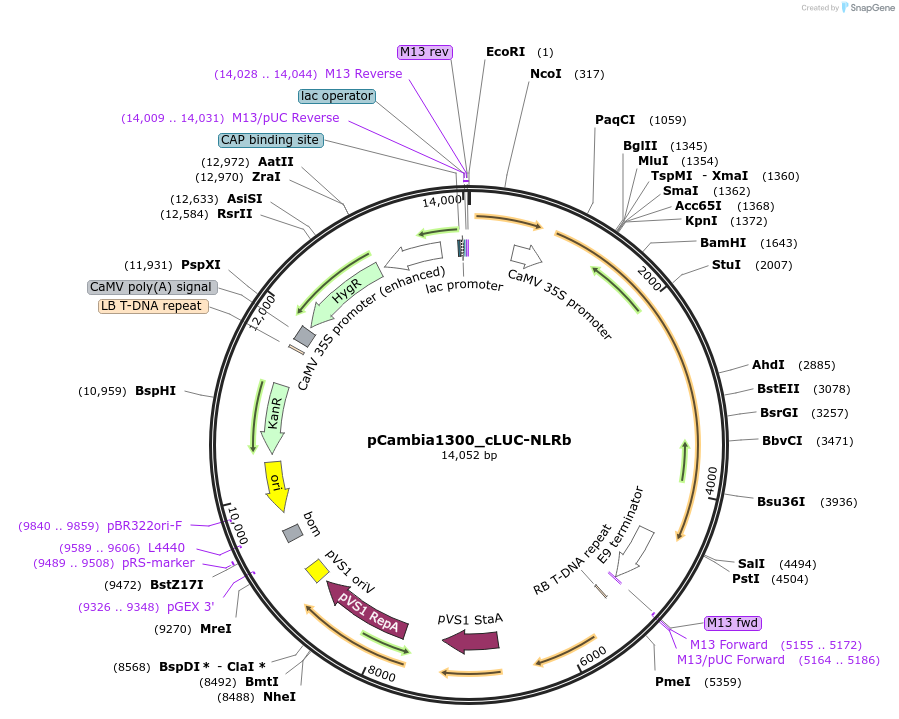pCambia1300_cLUC-NLRb
(Plasmid
#233527)
-
PurposeExpresses split luciferase fusion cLUC-NLRb in planta
-
Depositing Lab
-
Publication
-
Sequence Information
Ordering
| Item | Catalog # | Description | Quantity | Price (USD) | |
|---|---|---|---|---|---|
| Plasmid | 233527 | Standard format: Plasmid sent in bacteria as agar stab | 1 | $89 | |
Backbone
-
Vector backbonepCambia1300-cLUC
-
Backbone manufacturerZhao and Zhou 2020, doi: https://doi.org/10.11983/CBB19229
- Backbone size w/o insert (bp) 10935
-
Vector typePlant Expression
Growth in Bacteria
-
Bacterial Resistance(s)Kanamycin, 50 μg/mL
-
Growth Temperature37°C
-
Growth Strain(s)DH5alpha
-
Copy numberHigh Copy
Gene/Insert
-
Gene/Insert nameSr62NLRb
-
SpeciesTriticum aestivum
-
Insert Size (bp)3117
- Promoter 35S
-
Tag
/ Fusion Protein
- C-terminal fragment of Luciferase (N terminal on backbone)
Cloning Information
- Cloning method Restriction Enzyme
- 5′ cloning site KnpI (not destroyed)
- 3′ cloning site SalI (not destroyed)
Resource Information
-
Supplemental Documents
Terms and Licenses
-
Academic/Nonprofit Terms
-
Industry Terms
- Not Available to Industry
Trademarks:
- Zeocin® is an InvivoGen trademark.
Depositor Comments
Please visit https://doi.org/10.1101/2024.08.30.610287 for bioRxiv preprint.
A E180D mutation was found in HygR.
These plasmids were created by your colleagues. Please acknowledge the Principal Investigator, cite the article in which the plasmids were described, and include Addgene in the Materials and Methods of your future publications.
-
For your Materials & Methods section:
pCambia1300_cLUC-NLRb was a gift from Brande Wulff (Addgene plasmid # 233527 ; http://n2t.net/addgene:233527 ; RRID:Addgene_233527) -
For your References section:
A wheat tandem kinase sensor activates an NLR helper to trigger immunity. Chen R, Chen J, Outram MA, Powell OR, Arndell T, Gajendiran K, Wang YL, Ayliffe MA, Blundell C, Figueroa M, Sperschneider J, Vanhercke T, Tang D, Xu Y, Zhong G, Gardener C, Yu G, Gourdoupis S, Jaremko Ł, Matny O, Steffenson BJ, Boshoff WHP, Meyer WB, Arold ST, Dodds PN, Wulff BBH. bioRxiv 2024.08.30.610287 10.1101/2024.08.30.610287



